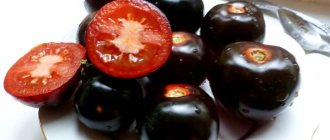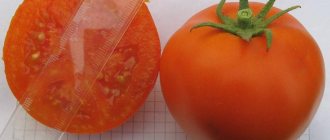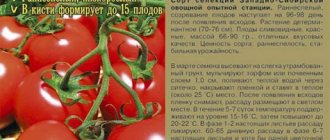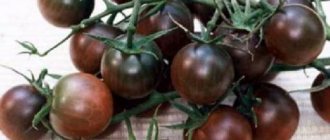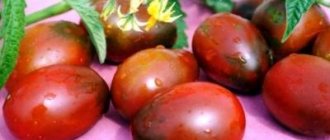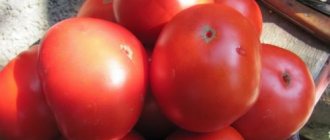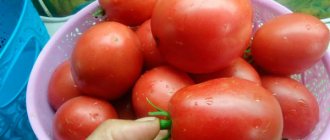Tomatoes are universal in use: they are used for making soups, salads, pasta, and juices. Tomatoes are good for fresh consumption and after heat treatment. Vegetables are grown both in open ground and in greenhouses.
Let's consider which varieties are best suited for greenhouse cultivation and how to choose tomato seeds that will provide you with a rich harvest.
Features of growing ultra-early ripening tomatoes in a greenhouse
An ultra-early tomato, as the name implies, produces the fastest possible harvest. First of all, pay attention to the choice of seeds for planting.
Some varieties are only suitable for greenhouse conditions. Research the seed manufacturer, find reviews from farmers, ask fellow gardeners about the features of a particular variety. Determine for what purpose you are growing the crop - some greenhouse varieties are suitable for canning and pickling, some are suitable for fresh consumption, as they cannot be stored for a long time.
Decide for yourself how much time you are willing to spend caring for the plant. There are tomatoes with high resistance to diseases and pests. In this case, your efforts and time costs will be minimal. Or vice versa - some varieties, having high yield and taste, are easily susceptible to disease, so they need to be monitored more carefully.
Important ! When growing tomatoes in a greenhouse, remember: the plant also needs regular watering, fertilizing and loosening the soil. The idea that greenhouse tomatoes require less care than tomatoes in open ground is erroneous.
Characteristics and description
Ultra-early tomato differs from other types in terms of ripening time. Ultra-early ripening varieties of tomatoes produce a harvest within 90 days after germination, tomatoes with medium ripeness - after 115 days, and late varieties - after 130 days. But ultra-early ripening ones will allow you to enjoy fresh vegetables after 80 days.
Early ripening tomatoes have many advantages, including:
- High and high-quality harvest in a short time.
- Ultra-early ripening varieties are much hardier, so they can be grown in Siberia and the Urals.
- There are varieties designed for growing in greenhouses and open ground.
- Tomatoes are not susceptible to late blight. The reason is that they mature faster than the period of defeat by this disease.
Ultra-early ripening tomato varieties for greenhouses
Let's look at varieties that are great for growing in a greenhouse:
- Amur standard . Many gardeners liked the bright red tomato. The variety does not require special care and is unpretentious to climatic conditions. It has dense juicy pulp and a sweetish taste. About 4 kg of tomatoes are harvested from one bush. The Amur standard tolerates picking well and practically does not form stepsons. Tomatoes are stored for a long time and retain good presentation and taste during transportation.
- Miracle of the Earth . Mid-season variety with large, beautiful heart-shaped tomatoes. It is best to use them fresh, since the vegetable cannot be stored for a long time. The bushes are tall, so a mandatory garter to the support is required. The miracle of the earth should be periodically fed with mineral fertilizers, as well as watered and weeds removed in a timely manner.
- Siberian early ripening . Juicy and aromatic fruits occupy a leading position among gardeners in central Russia. Low and compact bushes produce the first harvest within 110 days from planting. Siberian early ripening does not crack, is resistant to the vagaries of weather, and has a stable yield.
- Ultra-early ripening F1 . Fertile soils and sunny beds are best suited for this variety of tomato. In the shade, the vegetable ripens more slowly. We recommend using only warm water for watering. The variety is excellent for canning and pickling, as the fruits are small and compact.
- Apples in the snow are a productive early-ripening variety. The height of one bush is no more than 70 cm. Tomatoes ripen in clusters, 5-6 pieces per branch. The shape of the vegetable is round, the flesh is juicy, and the skin is thin. Apples on snow are often used to make tomato juice or paste, ketchup. Among the disadvantages, the variety is noted to be unstable to late blight, a fungal infection that affects most tomatoes.
- Pink miracle F1 . The ripening period is ultra-early - only 80 days. The variety is characterized by excellent productivity - about 18 kg of tomatoes are harvested from one bush. The pink miracle is easily transported. The weight of one tomato is about 80 g, the skin is soft, the taste is semi-sweet, juicy.
- Siberian pirouette . The fruits have an elongated shape with a pointed tip, a pleasant red-orange color. The height of one bush is about 2 m, and the plant needs pinching and garters. The variety has a short shelf life, so it is best to consume the vegetable fresh, for example, use it in salads or side dishes. It is easy to care for and resistant to weather changes.
- Korneevsky red . The variety appeared back in 1980. These tomatoes can be harvested before the maturity stage - the vegetable is able to ripen on its own at room temperature. The tomato itself is large, neatly shaped, and one weight is 400 g or more. The skin is thin, glossy. They are stored for a long time and are resistant to diseases. Korneevsky red should be watered in moderation - excess moisture can lead to cracking.
- Mystery . Compact bushes reach a maximum height of 0.5 m. The average weight of one tomato is about 80 g. The yield is average. Riddle has almost no stepsons, which, undoubtedly, has become an advantage of the variety. Due to its attractive presentation, tomatoes are often grown not only for personal use, but also for sale.
Planting and care
When growing the Ultra-early tomato variety, both seedling and non-seedling planting methods are used. Of course, for the name to justify itself, it makes sense to use the seedling method:
- in early March, the seeds germinate. To do this, the grains are folded into a damp cloth and placed in a warm place for 4-5 days. The textile fabric is constantly moistened so that the seeds do not dry out;
- the soil is poured into a specially prepared container, leveled and moistened. To keep the sprouts strong, it is advisable to use a special soil mixture for seedlings. On the surface of the earth, grooves are made with a depth of 1.5-2.5 cm, into which the seeds of Ultra-early ripening tomatoes are laid and covered with a thin layer of soil;
- To prevent the soil from drying out and maintaining a constant temperature, the container is covered with plastic film. It is not recommended to place the box in direct sunlight, as the seeds may simply “cook”;
- when the first shoots appear, the film is removed and the containers are placed in a warm, bright place. When two leaves appear on the seedlings, they are picked and planted in separate pots.
One and a half to two weeks before planting seedlings, they begin to harden them. To do this, the cups are taken out into the open air every day. Hardening begins in a few minutes. Before planting, seedlings should be outdoors all day.
Advice! The place for hardening is chosen protected from drafts and direct sunlight.
Ultra-early ripening seedlings are planted in the garden plot in early June, when there is no longer any danger of sudden frosts and the ground has warmed up sufficiently.
For planting Ultra-early ripening tomatoes, you can choose both sunny and shaded areas. But we must admit that in shady areas the harvest ripens later. This variety prefers light, fertile soils.
Tomato varieties of the Ultra Early Ripe variety can be planted in the form of rows of holes or trenches. The last method is the most convenient for watering.
Growing in a greenhouse
If you set up a greenhouse, the seedlings will receive additional protection. In this case, Ultra Early Ripe tomatoes can be planted earlier - approximately May 14-19.
In order for the seedlings to get used to the greenhouse conditions, the boxes with tomatoes are left under the film for two to three days. Moreover, it is advisable to open the film slightly for a day.
Important! In case of sudden frosts, the greenhouse can simply be covered with a thick cloth (blanket or bedspread).
Ultra early ripening tomato bushes are planted in holes arranged in two rows. You can use a 35x35 cm pattern. In row spacing, maintain a distance of 60-80 cm.
There are a lot of options for arranging greenhouses. You can build stationary structures (from boards, glass doors) or mobile, temporary ones.
Important! When erecting permanent structures, it is necessary to plant tomato varieties that will not create problems during courtship.
Stages of greenhouse construction
You will need PVC pipes, spunbond with a density of 30 kg sq. m. m, pegs.
- On a rectangular canvas, drawstrings 10 cm wide are adjusted in increments of 50-60 cm. The drawstrings must be positioned parallel to the narrow side of the canvas.
- PVC pipes are threaded inside the drawstrings.
- Along the bed with tomatoes (on both sides) pegs are installed at distances equal to the distances between the drawstrings on the canvas.
- The pipes are bent and placed on pegs.
There are many advantages to such a structure: the structure can be easily removed, it is easy to fold and put away for long-term storage, all the parts of the greenhouse can be simply replaced, the canvas can be easily assembled along arcs (when you need to open the greenhouse slightly).
After transplanting the seedlings into a greenhouse, it is watered and the soil is mulched so that a crust does not form on the surface of the earth. A week after transplantation, tomatoes of the Ultra-early ripening variety are treated with late blight agents.
Since tomatoes do not tolerate high humidity and temperatures above +30˚ C, the greenhouse must be opened slightly on hot sunny days.
Advice! As soon as constant warm weather sets in, it is advisable to completely remove the greenhouse.
Feeding and watering
Two to three weeks after planting the seedlings, it is recommended to apply fertilizer for the first time. For feeding, you can use the following solution: 25 g of nitrogen, 40 g of phosphorus, 15 g of potassium fertilizers are diluted in 10 liters of water. Approximately 0.5-0.6 liters of solution is poured under each bush.
For the following fertilizing, complex inorganic fertilizers are also used. The Ultra-Ripe tomato responds best to the application of potassium fertilizers.
But you can also use organic matter. The easiest way: dilute one liter of manure in 10 liters of water. Let this solution brew for 10-13 days. To fertilize tomatoes of the Ultra-early ripening variety, you need to dilute a liter of infusion with 10 liters of water and pour the final solution into the soil. A liter of fertilizer is enough for one bush.
Important! The periods of ovary formation and fruit formation are the most important for feeding.
When choosing the watering regime for the Ultra-early variety, you must keep in mind that tomatoes do not tolerate constant stagnation of moisture in the soil. Therefore, the best option is abundant but infrequent watering. It is important to take into account the climatic characteristics of the region.
When irrigating Ultra-Early ripening tomatoes, the general rules for watering tomatoes apply:
- Water should not get on the stems and leaves;
- in hot sunny weather, watering is carried out in the evening;
- in cloudy weather, you can water the tomatoes at any time;
- It is advisable to use warm, settled water for irrigation;
- The drip system is the most acceptable irrigation option.
The Ultra early ripening tomato variety can be considered unpretentious and to get a good harvest, it is enough to regularly loosen the soil and weed the weeds. To avoid damaging the root system, loosen the soil near the trunks carefully. Hilling of bushes is also carried out periodically.
Advice! Thanks to pinching of bushes, the yield of the Ultra-early variety increases.
The Ultra Early Ripe tomato is a standard variety, which means it is not necessary to tie up the bushes. However, according to reviews from summer residents, supports protect tomatoes from falling during natural disasters (heavy rain or rain). In addition, in cool areas, tying tomatoes provides ventilation to the bushes and protects against late blight.
Which regions are best to grow in?
Regions with a warm temperate climate and fertile soil are best suited for cultivation. The leaders here are the Krasnodar region, the Volgograd region, and the Astrakhan region. In these areas, tomatoes grow well in open ground conditions.
Fortunately, there are many varieties that are intended for cultivation in central Russia, as well as in the Northern regions of our country. For example, Siberian pirouette and Siberian early ripening have excellent resistance to frost, are not afraid of climate change and are characterized by stable yields.
The best varieties for the Urals are Babushkin Secret, Pink Flamingo and Samara.
Important ! Pay attention to air humidity. Tomatoes do not like excess moisture and begin to crack and quickly deteriorate. Also, due to excess moisture, fungus may develop.
"Leningrad chill"
The determinant hybrid “Leningrad Chill” grows small. The plant is only 40 cm high and is convenient to grow in small areas. When the weather is good in open ground and film shelters, an ultra-early ripening tomato is ready for harvest after 85 days. This determinate hybrid forms four clusters on the bush in open ground. Each of them produces nine tomatoes. Its fruits weigh 70 grams and have a slight sourness.
The yield of ultra-early ripening “Leningrad Chill” is small - only 3.4 kg per square meter.
But as an advantage, we can note the ability to grow this tomato in the northwestern regions with very unstable climatic conditions.
"Semko-98". The ultra-early ripening variety ripens on the 93rd day. The fruits weigh 80 grams. It is noteworthy that it is usually planted exclusively in the soil without additional protection.
“Junior”. This variety ripens in 85 days. An ultra-early ripening plant, the main inflorescences form on the side of the stems. It produces fruits weighing 100 grams.
"White filling". A plant 50 cm high is ready for tomato harvesting on the 85th day. The variety bears sour fruits weighing 130 grams. Simultaneous fruiting is noted as a distinctive property of an ultra-early ripening variety. This allows them to be processed efficiently and on time.
“Explosion” is an improved version of it. It is more cold resistant. The fruits of the plant weigh a little more - 150 grams. The bushes reach 40 cm.
"Amur standard". This is an ultra-early ripening variety, ripening on the 90th day after planting. A plant 50 cm high bears fruit weighing 80 grams. The advantage of the hybrid is its ease of care. "Amurskiy Stamb" grows well on cold days. The “Early Maturing Polar” variety was developed for cold climates. Its ripening occurs on the 98th day. This is a standard variety, which produces quite a few branches. The plant bears fruit weighing 150 grams.
"Alpha". This is a standard, ultra-early ripening tomato that produces a harvest in 87 days. The variety adapts to the environment and climate, even if you decide to plant it in the ground without seedlings. Grows up to half a meter. The Alpha variety bears fruits of small size, but they are very juicy.
"Ultra-early." The variety ripens in just 70 days. Its standard bushes reach 60 cm. The biggest advantage of this variety is good immunity. It is resistant to fusarium and other common diseases. This is a high-yielding, ultra-early variety that produces 15 kg of tomato per square meter, with the weight of each fruit being 100 grams.
Varieties for growing in a greenhouse
TOP 5 best varieties for growing in greenhouse conditions:
- King of Kings . The tomatoes are large and sweet. The weight of one varies from 500 to 1000 g. The bushes ripen within 125-135 days. Excellent resistance to rot and late blight. About 6 kg of tomatoes are harvested from one bush. The variety undoubtedly earned its name thanks to its excellent juicy taste.
- Verlioka . It is immune to most tomato diseases and has excellent taste. Housewives love Verlioka - tomatoes are universal in use and do not lose their quality after heat treatment. They ripen quickly - within about 95-105 days. The bushes are low. At the same time, the crop requires obligatory pinching and nutritious soil.
- Samara . Tall bushes require staking, otherwise the stem may break. Gardeners harvest about 4 kg of tomatoes from one bush. Samara is also versatile in use and unpretentious in care. Resistance to infections is average. Keeping quality is good.
- Honey cream . The variety is characterized by a sweet and sour taste. Ripens early - within only 90 days. The skin is dense, which is why the tomatoes are well stored and transported. The growth of the bush is small - only 60 cm. It takes well to mineral fertilizing and organic fertilizers.
- Openwork . Relatively new variety. Best suited for growing in regions with fertile soil. The weight of one fruit is about 300 g, the shape is slightly elongated, flattened. Summer residents harvest about 4 kg of tomatoes from one bush. The openwork requires the obligatory formation of a bush.
Restriction of plants in nutrition
The shock therapy method can literally make tomatoes yield faster.
This requires several procedures. First, at a distance of 10 cm from the ground, you need to make a cut on the tomato stem. Next, you need to place a wooden plate in it, the size of which is 50x200 mm. This is done to limit the supply of nutrients. In addition, the plant stem at a height of 10 cm can be tied with copper wire to achieve an identical effect. The bush itself should be slightly pulled out of the ground to damage its thin roots.
Some gardeners simply pierce the stem in several places with a toothpick. In all three cases, the tomatoes ripen faster by one to two weeks.
For growing in open ground
TOP 5 for growing varieties in open ground:
- Marisha . Universal tomatoes for open ground. Many gardeners love small, rich red tomatoes. The variety is adapted to extreme weather conditions.
- Agata is an early ripening variety, ripens within 100 days. The maximum height of the bush is about 45 cm, but this does not interfere with harvesting an excellent harvest. They ripen at the same time, so they are widely used for sale. The maximum weight of one tomato is 100 g. The pulp is sweet and dense.
- Ballerina - pinkish or raspberry elongated tomatoes. Resists fungal infections well. Ballerina is a universal tomato. The tomatoes themselves are small in size, so they are convenient to use in preparations and canning.
- Banana legs. The name speaks for itself: in appearance the fruits really look like small bananas. The color is pale yellow, the flesh is sweetish. Does not require pinching, tomatoes grow in clusters. Productivity is above average. Due to their unusual appearance, Banana Legs often become a decoration for any feast.
- Betalux ripens in 95 days from the date of planting. The bushes reach a height of only 40 cm, so they do not need a garter. There is also no need to step-up Betalux. Round shape, red color. The weight of one tomato is about 120 g, the flesh is fleshy and dense.
Advantages and disadvantages of ultra-ripe varieties
The possibility of obtaining an early harvest is the main advantage of the varieties. However, cultures have other advantages:
- early-ripening tomatoes do not suffer from late blight, since the main peak of infection is late summer-early autumn, when wet weather is often combined with a decrease in air temperature;
- The first tomatoes have a delicate aroma and a unique rich taste. As a rule, vegetables are consumed fresh or used for making fresh juice;
- ultra-early crops are characterized by high yields. Depending on the variety, a harvest weighing 7-17 kg is harvested per square meter of bed.
Depending on the preferences of the summer resident, early varieties with small fruits (such as cherry) can be planted, or tomatoes with a standard weight of 180-220 g will ripen.
Naturally, ultra-early tomatoes also have disadvantages. First of all, experienced gardeners note the low yield of some varieties and the need for constant pinching.
Features of variety selection
There are a great variety of different varieties today, so it is important to take into account all the nuances when choosing.
List of super early tomato varieties
If you do not want to wait a long time for the harvest, we advise you to pay attention to the following varieties:
- Aurora;
- Debut;
- Katyusha;
- Mystery;
- Sanka;
- Samara;
- King of Kings;
- Alpha.
short
Low-growing varieties will not only give you a rich harvest, but will also decorate the greenhouse with their appearance:
- Pink honey;
- Alaska;
- El Dorado;
- Supermodel;
- Betalux;
- Honey cream;
- Agatha.
Determinate and indeterminate
Determinate varieties mean that the bush will grow to a certain height and no more. Indeterminate ones, on the contrary, grow until their growth is artificially stopped.
The best determinate varieties:
- Bobcat;
- Linda;
- Mystery;
- Roma;
- Danko.
The best indeterminate varieties:
- Miracle of the Earth;
- Watermelon;
- Bull's Heart;
- Abakan pink;
- King of Siberia;
- Japanese crab.
Resistant to diseases and pests
Tomatoes, like other plants, are susceptible to various diseases. The most common of them: late blight (fungus on the bush), root rot, tobacco mosaic (can destroy the entire crop).
The most disease-resistant tomato varieties:
- Charisma F1;
- Vologda F1;
- Ural F1;
- Firebird F1;
- Koenigsberg;
- Chio-chio-san;
- Pot-bellied hut;
- Yablonko Russia.
Important ! There are no varieties in nature that are 100% protected from fungi, infections and pests. If a seed manufacturer writes on the packaging that a variety is not susceptible to pests, this is nothing more than a commercial move.
Nuances of agricultural technology
You can grow this ultra-early tomato variety either by seed or by seedlings. In March, the seeds are buried in fertilized soil, followed by covering the container with film. By regularly spraying the soil, ventilating it and creating comfortable growing conditions, you will quickly wait until the first leaves appear, when the plants can be planted in separate containers or transferred to a greenhouse. Before planting in open ground, do not forget to harden off the seedlings.
Low-growing, ultra-early ripening variety loves sandy and loamy soil with an abundance of humus and a neutral acidic reaction. You probably already know that it is impossible to plant tomatoes in the place where other representatives of the Solanaceae family used to be, but alternating them with cabbage, zucchini, carrots and onions is not only possible, but also necessary.
Judging by the reviews of those who planted, the ideal fertilizer is humus, a bucket of which is enough for three bushes. Before spring digging, the soil should be irrigated with a solution of copper sulfate. Don’t forget about feeding with mineral complexes.
The diameter of the hole for each bush should be 30 cm, and the distance between them should be 40 cm. Treat the seedlings with Bordeaux mixture before planting and be sure to cover the soil with a layer of mulch in the form of sawdust, humus and rotted leaves. In the future, the plants need to be regularly loosened, watered and properly cared for.
The lower leaves can be plucked to increase the access of air and light, and many gardeners know the secret of how to speed up the harvest.
To do this, plants are sprayed with a special solution consisting of a small amount of manganese sulfate, boric acid, zinc sulfate and copper sulfate. Some people prefer to use an iodine solution, adding 20 drops of this drug to 10 liters of water and watering their tomatoes.
Everyone has their own growing secrets, but in general, Ultra-early tomato does not require any special tricks. By caring for it in the same way as other varieties, you can get tasty and high-quality fruits, rich in vitamins and minerals.
That's all about this variety. If you have any questions, ask, I will be happy to answer. Good luck!
Rules for caring for early ripening varieties
To get a rich harvest you need:
- Give the crop fertilizer periodically. For example, a few days after planting, the soil should be fed with a Nitrophoska solution. This is a complex universal fertilizer based on phosphorus, nitrogen and potassium.
- Feed tomatoes during harvest. Magnesium sulfate or potash fertilizers are suitable for this.
- Water the crop as the soil dries out. Tomatoes do not like drought, but there is no need to fill them with water either. Excessive moisture leads to cracking of vegetables and the appearance of rot.
- Loosen the soil without damaging the stems and roots of plants.
- If necessary, trim and tie up bushes. Due to the tall growth and heavy weight, the stems may break.
Pests and diseases
The Ultra Early ripening variety practically does not suffer from diseases. The exception is late blight, which can occur with sudden changes in temperature and humidity. Therefore, when arranging greenhouses, you need to carefully monitor the bushes and avoid high humidity. For preventive purposes, it is recommended to spray the bushes with a solution of Bordeaux mixture.
Of the tomato pests, the whitefly and mole cricket deserve attention. The appearance of whiteflies leads to the appearance of a special coating on tomatoes and the plant dies over time. To get rid of whiteflies, you can spray the bushes with Confidor, Mospilan, Akellic.
The Ultra Early Ripe tomato variety is very undemanding and with minimal care produces a fairly good harvest. Therefore, even a novice gardener can plant such tomatoes and enjoy an early harvest.
Reviews from summer residents
Feedback from people regarding the choice of variety is mixed. Gardeners note a number of advantages of early-ripening tomatoes:
- the first harvest is not long in coming;
- low susceptibility of most varieties to frost and climate change;
- high productivity;
- ease of care.
However, some varieties are different:
- low or average taste;
- short shelf life;
- low immunity to late blight.
Important ! When choosing one variety or another, pay attention to its advantages and disadvantages. Choose only those tomatoes that are suitable for growing in your region.
Maria, Novosibirsk: “Early ripening tomatoes are my favorite. They are easy to care for and have good immunity to pests. My favorites are the Aurora and Ballerina varieties. I recommend them to all the gardeners I know.”
Stanislav, Ust-Katav, Chelyabinsk region: “I was dissatisfied with the early ripening tomatoes grown. I was not satisfied with the weak taste of the Roma variety. Next season I’ll try to plant another variety of early-ripening tomatoes - maybe they’ll taste better.”
Photo
To better understand what ultra-early ripening tomato varieties for greenhouses look like, you can look at the photographs below.
Ultra early ripening variety
Variety Alpha
Variety Amur standard
Variety Snowdrop
You can also watch this video, where an experienced gardener will tell you about the Ultra-early variety.
Ultra-early ripening varieties of tomatoes for greenhouses are a frequent choice of gardeners. Their main advantages: high and early yield, strong immunity to diseases and ease of care. And the sweet taste and pleasant aroma of such tomatoes will only add to their popularity.
Growing seedlings
This variety can be grown in two ways: seedlings and without seedlings, but to obtain an earlier harvest, it is better to use the first. In early March, seed preparation begins. To begin with, the seeds are disinfected; the procedure is carried out if the manufacturer has not taken care of this. Then, for germination, they are placed in a warm place on a damp cotton cloth for 4 days. However, the seeds should not be allowed to dry out.
A special container is filled with soil; it is advisable to take prepared soil for seedlings. Before sowing, the soil mixture is moistened and furrows are made approximately 1.5 centimeters deep. After planting the seeds, sprinkle a 1 cm layer of soil on top.
Before the first shoots appear, the container with the seeds is placed in a dark, warm place and covered with film, thus creating a greenhouse effect.
After the sprouts appear, the container with the seedlings is placed in a bright place, providing temperatures of +18 degrees during the day and +16 at night. When the seedlings produce a pair of true leaves, they are planted in separate containers with a capacity of 500 ml; you can use plastic cups. Important!
The place for the hardening procedure should be chosen carefully; it should be protected from direct sunlight and drafts.
Before planting, the seedlings undergo hardening; during the week they are taken out onto the street or balcony for the first time for 10-15 minutes, increasing the time spent in the fresh air every day.
Cooking recommendations
A few words should be said about the culinary characteristics of the variety:
- During heat treatment, the skin of tomatoes does not crack, so the variety is excellent for canning as a whole;
- Tomatoes of this variety are also good for fresh consumption, in salads;
- Due to the dense pulp (due to the low water content, long evaporation is not required) they are an excellent raw material for making juices, sauces, ketchup, and various home-made canned goods (borscht dressing, snacks).
It can be said about “ultra-early ripening” tomatoes that they fully deserve praise. But in order for these tomatoes to fully justify the name of the variety, they should be grown in greenhouses or by seedlings.
